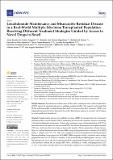Por favor, use este identificador para citar o enlazar a este item:
http://hdl.handle.net/10261/337834COMPARTIR / EXPORTAR:
 SHARE SHARE
 CORE
BASE CORE
BASE
|
|
| Visualizar otros formatos: MARC | Dublin Core | RDF | ORE | MODS | METS | DIDL | DATACITE | |

| Título: | Lenalidomide Maintenance and Measurable Residual Disease in a Real-World Multiple Myeloma Transplanted Population Receiving Different Treatment Strategies Guided by Access to Novel Drugs in Brazil |
Autor: | Santos Salgado, Anna Beatriz dos; Pessoa de Magalhães, Roberto J.; Pontes, R.; Silva Barbosa, Eduarda da; Flores-Montero, Juan; Sanoja-Flores, Luzalba CSIC ORCID; Gerardin Poirot Land, Marcelo; Pimenta, Glicinia; Santos Dutra, Hélio dos; Costa, Elaine S.; Orfao, Alberto CSIC ORCID ; Maiolino, Angelo | Palabras clave: | Multiple myeloma Measurable residual disease Lenalidomide Drug access Autologous transplant Maintenance Real-world study |
Fecha de publicación: | 4-mar-2023 | Editor: | Multidisciplinary Digital Publishing Institute | Citación: | Cancers 15(5): 1605 (2023) | Resumen: | Despite recent advances in multiple myeloma (MM), the incorporation of novel agents and measurable residual disease (MRD) monitoring in low-income countries remains a challenge. Although lenalidomide maintenance (M-Len) after autologous stem cell transplantation (ASCT) has been associated with improved outcomes and MRD has refined the prognosis of complete response (CR) cases, until now, there have been no data on the benefits of these approaches in Latin America. Here, we evaluate the benefits of M-Len and MRD using next-generation flow cytometry (NGF-MRD) at Day + 100 post-ASCT (n = 53). After ASCT, responses were evaluated based on the International Myeloma Working Group criteria and NGF-MRD. MRD was positive in 60% of patients with a median progression-free survival (PFS) of 31 months vs. not reached (NR) for MRD-negative cases (p = 0.05). The patients who received M-Len continuously had a significantly better PFS and overall survival (OS) than those without M-Len (median PFS: NR vs. 29 months, p = 0.007), with progression in 11% vs. 54% of cases after a median follow-up of 34 months, respectively. In a multivariate analysis, MRD status and M-Len therapy emerged as independent predictors of PFS (median PFS of M-Len/MRD− vs. no M-Len/MRD+ of NR vs. 35 months, respectively; p = 0.01). In summary, M-Len was associated with improved survival outcomes in our real-world MM cohort in Brazil, with MRD emerging as a useful reproducible tool to identify patients at an earlier risk of relapse. The inequity in drug access remains a hurdle in countries with financial constraints, with a negative impact on MM survival. | Versión del editor: | http://dx.doi.org/10.3390/cancers15051605 | URI: | http://hdl.handle.net/10261/337834 | DOI: | 10.3390/cancers15051605 | E-ISSN: | 2072-6694 |
| Aparece en las colecciones: | (IBMCC) Artículos (IBIS) Artículos |
Ficheros en este ítem:
| Fichero | Descripción | Tamaño | Formato | |
|---|---|---|---|---|
| Lenalidomide Maintenance_Santos_PV_Art2023.pdf | 1,58 MB | Adobe PDF |  Visualizar/Abrir |
CORE Recommender
Page view(s)
26
checked on 02-may-2024
Download(s)
17
checked on 02-may-2024
Google ScholarTM
Check
Altmetric
Altmetric
Este item está licenciado bajo una Licencia Creative Commons

